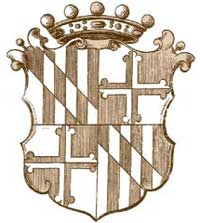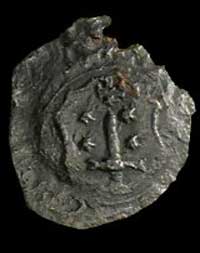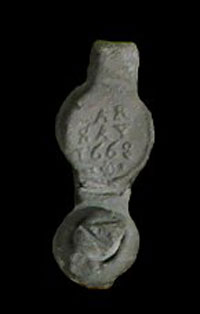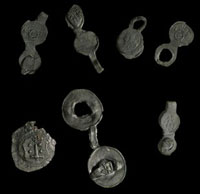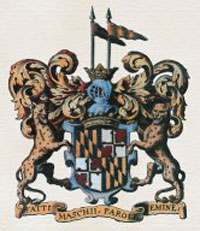Bale Seal
Excavations at the St. John’s site in St. Mary’s City continue to uncover unique objects and stories about this very important archaeological site. While many discoveries occur in the field, many discoveries are also made in the archaeological laboratory as the artifacts are cleaned, labeled, identified, and inventoried. A recently discovered flat lead artifact is a case in point.
Such lead objects are often referred to as cloth seals or bale seals. They served two basic purposes in the colonial period with some variation in form and function. Their primary function was to provide proof that cloth or other goods had met the standard set by the guild which controlled the materials in the bale. Most often, this was cloth since cloth was one of the most valuable and highly regulated and controlled materials in the 17th century. The English wool trade and other industrial crafts relating to textiles were the backbone of the British economy in the 17th century. Cloth seals attesting that the fabric met guild standards have been recovered from excavations throughout St. Mary’s City
Most of these are English, but a few Dutch examples have been recovered. We also find very similar seals that serve to indicate that the royal custom has been paid on the fabric. These usually take the form of multi-lobe seals that include the royal arms. In addition to either attesting to guild approval or payment of custom taxes, these seals actually served as tamper indicators. It is not possible to shorten a bolt of fabric without disturbing the seals, which would show that one is trying to cheat one’s customer.
The newly discovered lead seal (upper photo) is unique, however, in the archaeological excavations in St. Mary’s City.
This seal bears the arms of the Lord Baltimore. While somewhat decayed and deformed, the lead disk clearly has a cross bottony in one quadrant, and with only a little imagination one can see the second cross bottony in the opposing quadrant. The Calvert arms of six horizontal stripes, alternately gold and black, with a diagonal stripe of opposite colors (In heraldic terminology: Paly of six, Or and Sable, a bend counterchanged) can be seen in the remaining two quadrants.
We have contacted colleagues in England to solicit their opinions
Of particular significance in this regard was Geoff Egan of the division of Medieval and Later Finds with the Museum of London Specialist Services. Mr. Egan is the author of Lead Cloth Seals and Related Items in the British Museum (1994), considered the standard work on the subject. Mr. Eagan endorsed the identification of the Calvert arms and the attribution as a cloth seal. He stated that it was a unique example in his experience and quite unusual. He suggested that it was serving as an ownership identifier tag rather than a custom duties tag.
However, it is possible that the seal is an unusual customs duties tag since Maryland was a proprietary colony and such seals would likely reflect the arms of the ruling family. As a proprietary colony, the Calverts had rights and privileges not enjoyed by royal or company colonies. The seal could also have served as a chest seal or even a document case seal. Actual lead seals are occasionally used on documents from the Mediterranean region at this and earlier times although wax seals were most common. While the verdict is still out as to the exact function of this lead seal, it clearly indicates an association with the Calvert family and is the first 17th-century artifact to be found in Maryland which bears the Calvert family arms. Its discovery at St. John’s should not be surprising given the Calvert family’s and Maryland government’s long association with the house.
